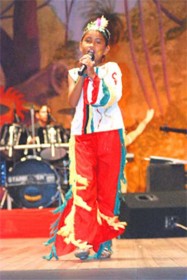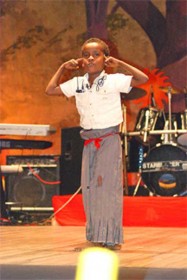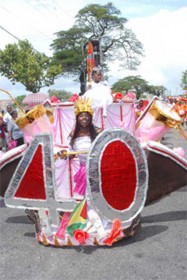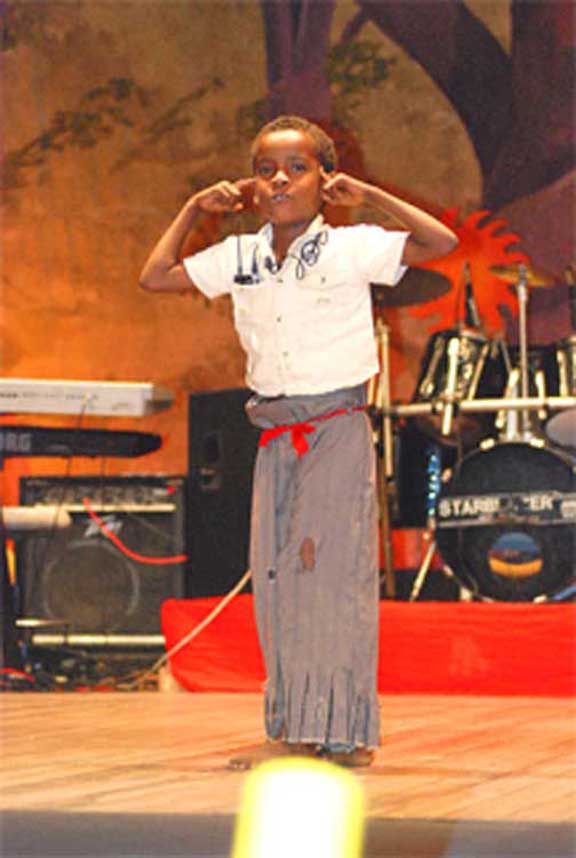On the 40th anniversary of Mashramani which celebrates Guyana’s attainment of republican status it is worth a brief note on the state of the cultural festival after four decades in 2010. What is revealed in this assessment is that there are signs that the festival has solidly established itself as a popular tradition, but there are still factors which reduce its strength and suggest that it is still a developing trend that needs to learn from the successes of similar national cultural festivals in other Caribbean territories.
 By all signs and reports Mashramani 2010 was a resounding, effective and well-managed celebration crowned by a grand ‘bumper’ event on February 23, which was grand and colourful with overwhelming popular participation. It can claim multiple successes.
By all signs and reports Mashramani 2010 was a resounding, effective and well-managed celebration crowned by a grand ‘bumper’ event on February 23, which was grand and colourful with overwhelming popular participation. It can claim multiple successes.
As has been the case for many years, the Children’s Mashramani was again among the most satisfying exhibits. Several schools from different parts of the country converged at the Cultural Centre in George-town for dramatic poetry, dance and calypso, showcasing a great deal of enthusiasm, theatrical spirit and creative energy. When these were wanting in the adult activities their presence has been a constant in the inter-schools competitions, suggesting that there is a future in these performing arts and in Mashramani. There is little evidence, however, that there is any direct line of development from the juniors to the seniors in the festival.

Interestingly, it is in the inter-schools activity that the original plan for Mashramani has been partly fulfilled. The original idea was that there would be cultural events in all the regions of Guyana from which the best would be selected and brought to Georgetown for the national festival which would then truly reflect the nation. This was never achieved, but the children’s competitions come somewhat close to the intention. Furthermore it is there that the carnival arts are consistently demonstrated. Costumes are designed and paraded both on stage and on the road more ardently and creatively than in the recent history of the adult equivalent. Actually, ‘King’ and ‘Queen’ of the bands costumes have virtually disappeared from the stage in senior Mashramani.
Gordon Rohlehr in a recent public lecture remarked that calypso is not dying as some have asserted. He has gone to minor and obscure competitions in Trinidad and heard finely crafted calypsos that remain unknown, but that would compete positively with the leading popular compositions. The Guyanese calypso has languished in the doldrums for years, but the 2010 Junior calypso winner is a winner in any company. I Don’t Want to be Born by a schoolgirl is one of the best social commentary kaisos heard anywhere in Guyana in 2010.
What is important, however, is on the other side of that coin, because another of the positive gains in Mashramani 2010 was a promising return of creative designs in float costumes and artistically structured bands. This had faded and had given way to bands of T-shirted revellers. 2010 did not reclaim the past where this is concerned, and did not bring back a succession of large bands displaying themes and concepts, but there were glimmers that a few more artistic designers were at work, which is an upward movement over the previous decade. Aligned to that was an increase in significant private sector participation. After boring years of prescribed ministry and public sector predictability those bands brought some encouraging colour.
 The spirit of Mashramani was another success because of its presence on the road as evidenced by a large increase in bands of whatever type tramping in the road procession. It was reflected in the size of the groups, the mood and atmosphere generated by the participation.
The spirit of Mashramani was another success because of its presence on the road as evidenced by a large increase in bands of whatever type tramping in the road procession. It was reflected in the size of the groups, the mood and atmosphere generated by the participation.
Ironically, perhaps the most impactful evidence of widespread national participation on February 23 was the unsightly aftermath of the day’s sport. Georgetown streets were horribly strewn with the disjecta membra, the scattered remains, the wantonly discarded garbage from a day and night of revels, picnics, food and drink. It was a sure sign that the cleaning-up and clearing-away machinery that should have swung into action in the tiny hours of the morning had broken down. It was evidence that the clean-up campaign had failed but that the popular festival had succeeded. The extent and copious distribution of the debris showed that Guyana had come out in unprecedented multitudes to celebrate Mashramani. The large numbers brought satisfaction because of the size of the crowds, but more than that because it was a multi-racial participation which is important for the future and integrity of a national festival.
 However, Mashramani still has cause to reassess its advances in other areas. On February 22, 2009, the ‘Arts on Sunday’ in the Sunday Stabroek had cause to comment on disturbing signals in three main events of Mashramani, viz, the competitions in chutney, soca and calypso. That comment included the following: “the heat of the competition has cooled and numbers have dwindled. It is not known whether the reigning monarch will defend the crown or will even turn up to any event.” The contests were marked by defending champions who simply did not bother to turn up and the absence of several leading performers at the national level. “The same performers who complain about marginalisation of calypso in Guyana seem not to recognise their role in keeping the art firmly in the national consciousness.”
However, Mashramani still has cause to reassess its advances in other areas. On February 22, 2009, the ‘Arts on Sunday’ in the Sunday Stabroek had cause to comment on disturbing signals in three main events of Mashramani, viz, the competitions in chutney, soca and calypso. That comment included the following: “the heat of the competition has cooled and numbers have dwindled. It is not known whether the reigning monarch will defend the crown or will even turn up to any event.” The contests were marked by defending champions who simply did not bother to turn up and the absence of several leading performers at the national level. “The same performers who complain about marginalisation of calypso in Guyana seem not to recognise their role in keeping the art firmly in the national consciousness.”
Unfortunately the exact remarks can be repeated in 2010. The same trend continued. The 2009 Soca Monarch Shelly G, (Shellon Garraway), did not think it necessary to bother to show up to defend her crown. For reasons not made known, the reigning monarch in the Chutney Competition, Rajesh Dubraj, did not appear to defend his title. In 2009 the Soca King Adrian Dutchin put in a similar non-appearance and the excitement of tradition in the culture of these contests collapsed. The performers treat their own flagship popular events with disregard, ignorance and arrogance, not knowing that it is also up to them to keep themselves in the market by keeping popular interest in these competitions high. It has been said in Dutchin’s defence that he had won the crown three times and he left it to others to have the opportunity. How noble, how utterly selfless, how self-important – Mr Dutchin has arrived; what a piece of conceit and arrogance and what a false sense of worth.
Far, far better, far more successful and accomplished artistes in Trinidad and Barbados never think that way or believe it is cute to simply not show up for the finals. Who are the Guyanese equivalents to see themselves as so large that they have risen above the national monarchy? The Mighty Chalkdust who has achieved more than a lifetime of accomplishments, including a doctorate in the subject, and who has won the crown more times than he can remember to count, still came back to win again in 2009. He returned to defend it in 2010, never thinking he was such an emperor that he should condescendingly leave the younger pretenders to take his crown. In chutney, soca and calypso there is a tradition and a culture of the reigning monarch defending the kingdom. All the leading contenders see it as the greatest prize and honour to fight each year for the crown and for the road march. It also need not be said how much money and fame they stand to earn. These are things the Guyanese like Shelly G, Dubraj and Dutchin are yet to learn.
 Furthermore, Dutchin was given one of his ‘victories’ by a questionable act that has blemished the soca contest. Ironically, it has caused Big Red (Michelle King) never to return to the competition because the crown was taken back from her and handed to Dutchin following “a miscalculation in the judges‘ scores.” That would have brought about a national catastrophe in Barbados where these contests are taken as seriously as the general elections.
Furthermore, Dutchin was given one of his ‘victories’ by a questionable act that has blemished the soca contest. Ironically, it has caused Big Red (Michelle King) never to return to the competition because the crown was taken back from her and handed to Dutchin following “a miscalculation in the judges‘ scores.” That would have brought about a national catastrophe in Barbados where these contests are taken as seriously as the general elections.
There are other issues in the way these Mashramani contests are organized, and the comment made in 2009 ‘Arts on Sunday’ is still relevant: “While it is a deliberate ploy to take the activities to the regions and hold the semi-finals and/or the finals in a location far from Georgetown, the practice is a bit counter-productive. To make things worse, they have at times been deliberately time-tabled to clash with each other. “What these events need is greater prominence, more glitter, fanfare and prestige. Each competition should be a major production under a powerful spotlight in a setting of well stage-managed grandeur. Mashramani can take note of the way similar monarchies have contributed to the popular sub-culture and to the success of carnival and crop-over. It has to, if it wishes to close the great gap that exists between it and those older traditions which have the benefits of history.”

